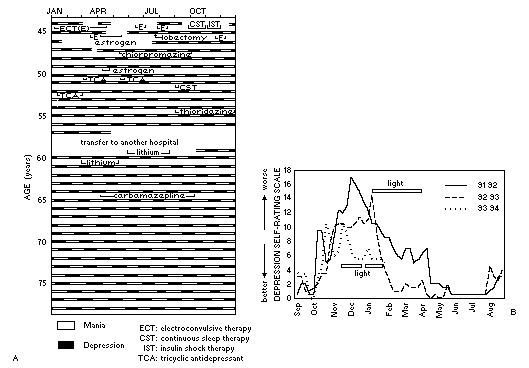
| FIG. 1 |
 |
| A: Clinical records (35 years) of a rapid-cycling manic-depressive woman were analyzed. The precision of cycling was within 2–4 days. No drug treatment affected the periodicity. However the manic–depressive cycles showed a positive correlation with age, beginning with a length of 21 days at 50 years and extending to 28 days at 80 (0.27 days/year). The number of manic days in summer tended to be longer than in the other three seasons. Reprinted with permission from ref. 40. B: Long-term prospective weekly self-ratings (von Zerssen scale, ratings higher than 6 document increasing depressive symptoms) in a diagnosed SAD patient (52-year-old woman) following successful participation in a light therapy trial in 1990 (study summarized in ref. 74). In the winter of 1991–1992 she had no treatment of any kind. Thus the onset of depression in October and the spontaneous remission in April represents the natural time course of the illness. In the winter of 1992–1993 she decided late in the season to initiate light therapy. This induced rapid amelioration and shortened the depressive phase by approximately 2 months. In the winter of 1993–1994 she initiated light therapy at the onset of depression in autumn, which prevented the appearance of a major depressive episode. Wirz-Justice et al., unpublished data. |
| Back to Chapter |
published 2000